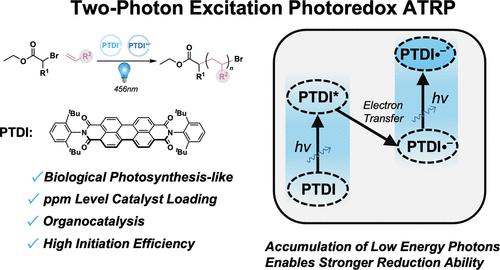当前位置:
X-MOL 学术
›
J. Am. Chem. Soc.
›
论文详情
Our official English website, www.x-mol.net, welcomes your
feedback! (Note: you will need to create a separate account there.)
Two-Photon Excitation Photoredox Catalysis Enabled Atom Transfer Radical Polymerization
Journal of the American Chemical Society ( IF 14.4 ) Pub Date : 2023-05-30 , DOI: 10.1021/jacs.3c02832 Yu-Ying Yang 1 , Pengfei Zhang 1 , Nikos Hadjichristidis 1
Journal of the American Chemical Society ( IF 14.4 ) Pub Date : 2023-05-30 , DOI: 10.1021/jacs.3c02832 Yu-Ying Yang 1 , Pengfei Zhang 1 , Nikos Hadjichristidis 1
Affiliation

|
In recent years, metal-free photoredox-catalyzed atom transfer radical polymerization (O-ATRP) has gained wide attention because of its advantages (e.g., no metal contamination and mild reaction conditions). However, this traditional one-photon excitation catalysis has thermodynamic limits. Most photocatalysts cannot effectively reduce the initiators and drive the polymerization under visible light. Herein, we investigate the two-photon excitation-catalyzed O-ATRP, in which the catalyst can absorb two photons to accumulate energy. Compared to one-photon excitation catalysis, this method not only has distinct advantages in the controllability, reaction rate, and catalyst loading but also can chemically reduce the various initiators (e.g., aryl halides) to initiate the polymerization. Density functional theory (DFT) calculation reveals that the two-photon excitation process reached a higher energy end state with stronger reduced ability via a thermodynamically more stable intermediate. We believe that this work will provide a new strategy for photoredox-catalyzed O-ATRP.
中文翻译:

双光子激发光氧化还原催化原子转移自由基聚合
近年来,无金属光氧化还原催化原子转移自由基聚合(O-ATRP)因其无金属污染、反应条件温和等优点而受到广泛关注。然而,这种传统的单光子激发催化具有热力学限制。大多数光催化剂在可见光下不能有效减少引发剂并驱动聚合。在此,我们研究了双光子激发催化的O-ATRP,其中催化剂可以吸收两个光子来积累能量。与单光子激发催化相比,该方法不仅在可控性、反应速率和催化剂负载量方面具有明显的优势,而且可以化学还原各种引发剂(如芳基卤)来引发聚合。密度泛函理论(DFT)计算表明,双光子激发过程通过热力学更稳定的中间体达到了更高的能量最终状态,具有更强的还原能力。我们相信这项工作将为光氧化还原催化的O-ATRP提供新的策略。
更新日期:2023-05-30
中文翻译:

双光子激发光氧化还原催化原子转移自由基聚合
近年来,无金属光氧化还原催化原子转移自由基聚合(O-ATRP)因其无金属污染、反应条件温和等优点而受到广泛关注。然而,这种传统的单光子激发催化具有热力学限制。大多数光催化剂在可见光下不能有效减少引发剂并驱动聚合。在此,我们研究了双光子激发催化的O-ATRP,其中催化剂可以吸收两个光子来积累能量。与单光子激发催化相比,该方法不仅在可控性、反应速率和催化剂负载量方面具有明显的优势,而且可以化学还原各种引发剂(如芳基卤)来引发聚合。密度泛函理论(DFT)计算表明,双光子激发过程通过热力学更稳定的中间体达到了更高的能量最终状态,具有更强的还原能力。我们相信这项工作将为光氧化还原催化的O-ATRP提供新的策略。










































 京公网安备 11010802027423号
京公网安备 11010802027423号